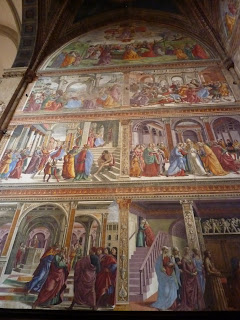But the day was redeemed entirely when we made our way to the church of Santa Maria del Carmine and its Brancacci Chapel, one of the greatest sites of early Renaissance work, the frescoes of Masaccio (and his pal Masolino and much later Lippi). According to Vasari, every great Renaissance painter came to Brancacci to study what Masaccio had achieved. Masaccio traveled in the very fast company of Donatello and Brunelleschi, but died very young, at age 28. I seem to remember reading that Leonardo had said that the Renaissance had two fathers: Giotto and Masaccio. Or maybe it was Norman Rockwell that said that. Anyhow, it's all here, and all new: perspective, volume, realism, emotion, and great color.
 |
Brancacci Chapel |
 |
You can stand that close; and take photos! |
 |
Masolino's Temptation |
 |
Masaccio's Expulsion |
 |
Most of the Brancacci is about St. Peter: here, his Healing the Son of Theophilus |
 |
St Peter healing by the power of his shadow alone (it's a long story) |
 |
Raising Tabitha from death |
 |
A detail from one of the Masoccio' frescoes: one of the most reproduced of all Renaissance images |
 |
St. Peter condemned by the proconsul |
 |
One entire wall |
 |
The other |


















































